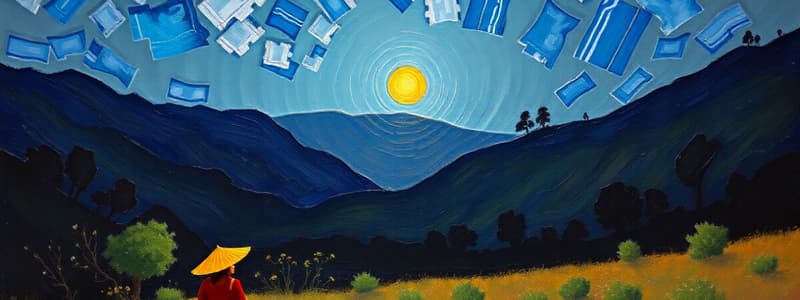Podcast
Questions and Answers
What aspect of Inka textiles notably reflects Inka philosophy and practice?
What aspect of Inka textiles notably reflects Inka philosophy and practice?
- The materials sourced from the jungle
- The use of colors in weaving
- The geometry of design (correct)
- The patterns of folklore
Who is credited with teaching the Andean people to spin and weave according to Inka origin myths?
Who is credited with teaching the Andean people to spin and weave according to Inka origin myths?
- Cuzco's ruling elites
- Juan de Betanzos
- Mama Occlo (correct)
- Guaman Poma de Ayala
What was the primary purpose of the Inka textiles made by royal weavers?
What was the primary purpose of the Inka textiles made by royal weavers?
- To decorate the temples of Cuzco
- To represent the identity of the Inka empire (correct)
- To be used as currency in trade
- To serve as everyday clothing for commoners
Which of the following elements is NOT associated with the quality of Inka textiles?
Which of the following elements is NOT associated with the quality of Inka textiles?
What role did Spanish and indigenous authors of the 16th and 17th centuries play regarding Inka textile traditions?
What role did Spanish and indigenous authors of the 16th and 17th centuries play regarding Inka textile traditions?
Which natural source is primarily responsible for producing a brilliant crimson dye?
Which natural source is primarily responsible for producing a brilliant crimson dye?
What significant archaeological site provides evidence of early blue-dyed fibers?
What significant archaeological site provides evidence of early blue-dyed fibers?
How did artisans in Ocucaje apply the purple colorant derived from shellfish?
How did artisans in Ocucaje apply the purple colorant derived from shellfish?
What cultural significance is associated with the distinct styles and patterns of garments in ancient Andean society?
What cultural significance is associated with the distinct styles and patterns of garments in ancient Andean society?
Which characteristic of yarn spinning varied from region to region in ancient Andean textile production?
Which characteristic of yarn spinning varied from region to region in ancient Andean textile production?
Flashcards
Cochineal Insect
Cochineal Insect
A small insect that produces a brilliant crimson dye.
Indigo
Indigo
A blue dye extracted from tropical plants, especially the Indigofera plant.
Indican
Indican
The molecule responsible for the blue color in indigo dye.
Shellfish Dye
Shellfish Dye
Signup and view all the flashcards
Viracocha
Viracocha
Signup and view all the flashcards
Inka Textiles
Inka Textiles
Signup and view all the flashcards
What did the Inka consider their role regarding textiles?
What did the Inka consider their role regarding textiles?
Signup and view all the flashcards
Mama Occlo
Mama Occlo
Signup and view all the flashcards
Inka Weaving Aesthetic
Inka Weaving Aesthetic
Signup and view all the flashcards
Inka Textiles and Their Significance
Inka Textiles and Their Significance
Signup and view all the flashcards
Study Notes
Andean Textile Traditions and the Inka
- Inca textiles (1438-1532 AD) are renowned for their geometric designs and high-quality weaving.
- These textiles, particularly those made by royal weavers, were used by noble families and officials.
- The textiles represent the Inca empire, embodying control, identity, perfection, consistency, and the value of material quality and processes.
- They demonstrate an understated aesthetic and exemplify Inca philosophy and practice.
- The textiles were made of high-quality materials, meticulously and regulated weaving process.
Andean Textile Traditions
- Origin myths, recorded by Spanish and indigenous authors, highlight the importance of textiles and weaving as a powerful source of Inca identity in the Andes.
- Pre-Inca Andean people were essentially naked or wore garments made of leaves or skins.
- According to indigenous author Guaman Poma de Ayala, the Inka queen Mama Occlo taught the people how to spin and weave.
Andean Civilizations and Textiles
- Andean civilizations began developing weaving as early as 4500 BCE.
- Different environmental zones (dry deserts, snow-capped mountains, river valleys) influenced the characteristics of textiles developed in those regions.
- Cotton originated in coastal valleys.
- Camelid (llama, alpaca, vicuña) fibers were cultivated in the highlands, prized for their soft, silk-like qualities.
- Natural dyes (earths minerals, organic tannins from plants) were used to create diverse colors in textiles.
- Color variations in animal fibers were further developed.
- Animal husbandry was important to the development of textile production.
Inka Garments
- Inca official garments are recognizable for their design, format, and quality of weaving.
- Male garments consist of tunics.
- Women's garments are composed of wrapped dresses pinned at the shoulder and at the waist.
- The Inka king changed garments when traveling, as a sign of respect for local authorities.
Colonial Textiles
- Inka textiles were sometimes seamed together from rectangular lengths of cloth that were never cut.
- The use of tocapu (a purely colonial invention), geometric patterns organized in a diagonal alignment, was combined with European motifs on garments.
- Some garments were decorated with European heraldic imagery.
- The study of 17th-18th-century colonial textiles can help contextualize the significance of production and the process of Inka textiles.
- Inca-style garments were used in colonial processions and festivals, showcasing a connection to Inka heritage.
Inka and Colonial Sources
- Inka textile traditions and functions were understood through preserved garments (with limited archaeological context), Colonial documents, paintings, and manuscripts.
- The materials, techniques, designs, and meanings of Inka textiles are significant aspects of Inca society's aesthetic and culture.
Studying That Suits You
Use AI to generate personalized quizzes and flashcards to suit your learning preferences.




